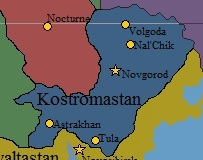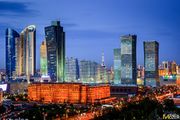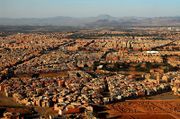Difference between revisions of "Kostromastan"
Tuvaltastan (Talk | contribs) (→Industry) |
Tuvaltastan (Talk | contribs) |
||
| Line 55: | Line 55: | ||
|calling_code = +18 | |calling_code = +18 | ||
}} | }} | ||
| − | '''The Democratic Republic of Kostromastan''', commonly known as [[Kostromastan]], is a landlocked nation that exists on the continent Aurora that borders Baykalia and [[Xiopothos]] to the north, Tuvaltastan to the south, Ethalria to the west, and | + | '''The Democratic Republic of Kostromastan''', commonly known as [[Kostromastan]], is a landlocked nation that exists on the continent Aurora that borders Baykalia and [[Xiopothos]] to the north, Tuvaltastan to the south, Ethalria to the west, and Caltharus to the northwest. Kostromastan exists between the latitudes 28 S and 40 S, and between the longitudes 120 E and 140 E. The nation, with a Nominal GDP per capita of $4,427.28, has an estimated population of 20,003,248. The largest city and capital Novgorod holds 12,768,513 individuals, 63.8% of the population. |
The History of Kostromastan is greatly intertwined with its neighbors [[Baykalia]] and [[Tuvaltastan]], and goes back as far as 1,700 B.C.E., beginning with the Ancient Kostuvians and their immense empire that encompassed central Aurora and a number of small islands north and south of the continent, as well as part of what is now modern-day Dragonia. The [[Kostuvian Empire]] existed for 1,032 years, and was succeeded by [[Kostuvastan]] in 12 A.D. Kostuvastan existed for 1,973 years until the three major culture groups (Baykalians, Tuvalts, and Kostros) began the [[Kostuvastan Civil War]]. The three culture groups, after the Civil War, founded the three nations Tuvaltastan, Kostromastan, and Baykalia. To this day, the three do not get along, and it is not uncommon for there to be violent and typically bloody border skirmishes amongst the three. | The History of Kostromastan is greatly intertwined with its neighbors [[Baykalia]] and [[Tuvaltastan]], and goes back as far as 1,700 B.C.E., beginning with the Ancient Kostuvians and their immense empire that encompassed central Aurora and a number of small islands north and south of the continent, as well as part of what is now modern-day Dragonia. The [[Kostuvian Empire]] existed for 1,032 years, and was succeeded by [[Kostuvastan]] in 12 A.D. Kostuvastan existed for 1,973 years until the three major culture groups (Baykalians, Tuvalts, and Kostros) began the [[Kostuvastan Civil War]]. The three culture groups, after the Civil War, founded the three nations Tuvaltastan, Kostromastan, and Baykalia. To this day, the three do not get along, and it is not uncommon for there to be violent and typically bloody border skirmishes amongst the three. | ||
Revision as of 03:10, 27 December 2016
| The Democratic Republic of Kostromastan | ||||
|---|---|---|---|---|
|
||||
| Motto: Motto Unavailable | ||||
| Anthem: "O Beautiful Kostromastan" | ||||
| Capital and largest city | Novgorod | |||
| Official languages | Codexian and Kostuvian | |||
| Ethnic groups (2015 Estimate) | 89.8% Human
8.2% Lupine 2% Other |
|||
| Demonym | Kostrom, Kostromi, Kostro, Kostromastani, Kostromastanian | |||
| Government | Democratic Republic | |||
| - | President | Albert Lewinsky | ||
| - | Vice President | Romov Wazlonski | ||
| - | Lead of the Cabinet | Robert Orevon | ||
| Legislature | Congress | |||
| - | Upper house | House | ||
| - | Lower house | Senate | ||
| Area | ||||
| - | Total | N/A km2 610,600 sq mi |
||
| Population | ||||
| - | 2015 estimate | 20,003,248 | ||
| - | 2010 census | 19,164,355 | ||
| - | Density | N/A/km2 N/A/sq mi |
||
| GDP (nominal) | 2015 estimate | |||
| - | Total | $88.56 billion | ||
| - | Per capita | $4,427.28 | ||
| Gini (2016) | 31.2 medium |
|||
| HDI (2016) | .689 medium |
|||
| Currency | Kostrom Kirib (K♅) |
|||
| Date format | MM/DD/YYYY | |||
| Drives on the | the right | |||
| Calling code | +18 | |||
| ISO 3166 code | KOS | |||
| Internet TLD | .kos | |||
The Democratic Republic of Kostromastan, commonly known as Kostromastan, is a landlocked nation that exists on the continent Aurora that borders Baykalia and Xiopothos to the north, Tuvaltastan to the south, Ethalria to the west, and Caltharus to the northwest. Kostromastan exists between the latitudes 28 S and 40 S, and between the longitudes 120 E and 140 E. The nation, with a Nominal GDP per capita of $4,427.28, has an estimated population of 20,003,248. The largest city and capital Novgorod holds 12,768,513 individuals, 63.8% of the population.
The History of Kostromastan is greatly intertwined with its neighbors Baykalia and Tuvaltastan, and goes back as far as 1,700 B.C.E., beginning with the Ancient Kostuvians and their immense empire that encompassed central Aurora and a number of small islands north and south of the continent, as well as part of what is now modern-day Dragonia. The Kostuvian Empire existed for 1,032 years, and was succeeded by Kostuvastan in 12 A.D. Kostuvastan existed for 1,973 years until the three major culture groups (Baykalians, Tuvalts, and Kostros) began the Kostuvastan Civil War. The three culture groups, after the Civil War, founded the three nations Tuvaltastan, Kostromastan, and Baykalia. To this day, the three do not get along, and it is not uncommon for there to be violent and typically bloody border skirmishes amongst the three.
Contents
Etymology
The word "Kost" directly stems from the original Kostuvastan, while the "rom" in the name translates to "desert" in Codexian and "KtbCKh" in Kostuvian.
History
Separation of Kostuvastan
(See Kostuvastan)
Beginnings of Kostromastan
Kostromastan, along with Tuvaltastan, were officially independent on the day October 17th, 2005. The newly-formed nation spent 21 months writing the constitution, due to the fact that not every province, particularly the Astrak and Tula provinces, was happy with each new iteration of the constitution. It was continually refined, until on July 12th, 2007, the Kostrom Constitution was finally offically ratified. It basically established an umbrella government of the five provinces that more or less manages the five provinces. Most governmental activities, however, take place withing provincial borders. The only activities that the national government takes part in are larger advisory, congressional, parliamentary, and executive issues such as civil rights and constitutionality of bills.
Modern-Day Kostromastan
The Kost-Tuva War (2009-2010)
Politics
Governmental System
Every position in every branch of government is elected through a popular vote. Each candidate is given 10,000CR to campaign with, and most candidates also accept donations from individuals and organizations such as activist groups and companies.
Executive Branch
The Executive Branch is made up of a council of five Presidents (one for each province), who vote whether to pass or veto bills proposed by Congress or Parliament.
Congressional Branch
The Congressional Branch is a legislative branch of government that discusses bills sent from Parliament. The bills that get approved are sent to the Executive Branch, and also makes those bills passed by the Executive Branch into law. Before it is passed, it must be screened by the Advisory Branch beforehand. Congress is made up of 25 members, five members for each province.
Parliamentary Branch
The Parliamentary Branch is where most of the dirty work takes place, per se. The Provincal Legislatures send their representatives (number of representatives per province is based on population: 1 Representative per 250,000 people) to Parliament with the proposed bills from each province, and discuss the bills proposed. The proposed bills that get approved by Parliament are sent to Congress and the Advisory Branch.
Advisory Branch
The Advisory Branch determines whether a proposed bill follows the Constitutional standards.
Domestic Policy
Each province has dominion over their own territory, and have their own laws and constitutions.
Foreign Policy
Kostromastan has multiple embassies, being in The Grand Duchy of Dragonia, Stratarin, Tretrid, The Three States of Fortuna and Emberwood Coast.
Electoral Process
Military
(Main article: Military of Kostromastan)
The military makes up 15% of Kostromastan's governmental budget of $46.9 billion, which is approximately $7.035 Billion.
| Military Branch | Funding | |
|---|---|---|
| Ground Forces | $4,500,000,000 | |
| Subterran Forces | $1,299,000,000 | |
| Air Forces | $1,236,000,000 | |
Culture
Food
Customs and Traditions
Literature
Music
Festivities
Holidays
Measuring Systems
Length
The base unit of length is the meter, which is defined as the length light travels in 1/299792458 instants (see Time).
1 Meter = 100 Centimeters
1 Centimeter = 100 Millimeters
100 Meters = 1 Kilometer
100 Kilometers = 1 Terameter
100 Terameters = 1 Exameter
Area
The base unit of area is the rotor, which is equal to 1 meter squared.
1 Rotor = 100 Centirotors
1 Centirotor = 100 Millirotors
100 Rotors = 1 Kilorotor
100 Kilorotors = 1 Terarotor
100 Terarotors = 1 Exarotor
Volume
Liquid
The base unit of volume (Lq) is the liter, which is defined as four times the amount of liquid that can fit inside the Human stomach.
1 Liter = 100 Centiliters (Colloquial: Ounce)
1 Centiliter = 100 Milliliters
100 Liters = 1 Kiloliter
100 Kiloliters = 1 Teraliter
100 Teraliters = 1 Exaliter
Solid
The base unit of volume (Sd) is the maud, which is equal to one cubic centimeter of water at its maximum density.
1 Maud = 100 Centimauds
1 Centimaud = 100 Millimauds
100 Mauds = 1 Kilomaud
100 Kilomauds = 1 Teramaud
100 Teramauds = 1 Examaud
Time
The base unit of time is the instant, which is defined by how long it takes light to travel 300,000,000 meters
10 Instants = 1 Second
6 Seconds = 1 Minute
10 Minutes = 1 Standard
6 Standards = 1 Hour
6 Hours = 1 Quarter
4 Quarters = 1 Day
6 Days, except for the last week in each month, which has 7 Days (except Ral) = 1 Week
10 Weeks = 1 Month
6 Months = 1 Year
Every four years (a leap year), a Londay is added to Ral, but then taken away when not on a leap year.
| Days in a Week |
|---|
| Rilday |
| Perday |
| Nenday |
| Yirday |
| Quanday |
| Olnday |
| Londay |
Londay happens every last week in a month, except Ral.
| Months in a Year |
|---|
| Ral |
| Pir |
| Naq |
| Yon |
| Hir |
| Pid |
Numbers
| Number | Pronunciation | Spelling | Number | Spelling | |
|---|---|---|---|---|---|
| 1 | Ooh | U | 10 | Tin | |
| 2 | Too | To | 10^2 | Hin | |
| 3 | Ray | Ree | 10^3 | Rin | |
| 4 | Fore | Foar | 10^4 | Lin | |
| 5 | Five | Phyve | 10^5 | Kin | |
| 6 | Shix | Shicks | 10^6 | Ton | |
| 7 | Snayn | Shneven | 10^7 | Tin-Ton | |
| 8 | Ain't | Aeighnte | 10^8 | Hin-Ton | |
| 9 | Nyan | Pmneiyane | 10^9 | Rin-Ton |
Pattern continues all the way to Kin-Kon, which is 10^30. The largest named real number is 10^365, which is Moogalplixianthianos
Geography
Climate
Kostromastan is engulfed in a desert. The only places where life can survive is along the Salov River, which runs through the entirety of Kostromastan. The only city that is not along the Salov is Tula, which is an experimental city, those experiments including an experiment to see if water can be captured from air, specifically desert air.
Ecosystem
Due to the entirety of the country being in a desert, there are few living things. A small number of desert animals and plants do exist however, which include the burrowing desert mole, the trelik plant, the Polinski rat, and the drilling worm. Interestingly, the drilling worm was the inspiration behind the Subterran Forces in former Kostuvastan.
Economy
Agriculture
Most food is imported from other nations, Tuvaltastan being the largest provider of livestock. There are efforts to minimize imports of food, pushed by a few activist groups. None of these groups have made it far into the national government, however.
Industry
The primary industries in Kostromastan revolve around mining and design. The mines of Kostromastan predominantly extract platinum and copper.
Science and Technology
Kostromastan has not been as fortunate as its fellow former Kostuv territories, and has duly been behind in technological and scientific advancements. Nonetheless, there has been a very successful effort to curb smog in Kostrom cities, and as a result Volgoda, Novgorod, Tula, and Nal'Chik are at least 90% powered by renewable energy.
Demographics
| City Name | Population of City | |
|---|---|---|
| Total | 20,003,248 | |
| Novgorod | 12,768,513 | |
| Volgoda | 4,317,942 | |
| Nal'chik | 1,273,541 | |
| Tula | 1,004,762 | |
| Astrakhan | 638,490 | |
Ethnicity
| Ethnicity | Population of Ethnicity | |
|---|---|---|
| Total | --- | |
| Human | --- | |
| Lupine | --- | |
| Tuvalt | --- | |
| Baykalian | --- | |
| Xiopothan | --- | |
Religion
| Religion | Population of Religion | |
|---|---|---|
| Catholicism | --- | |
| Buddhism | --- | |
| Unaffiliated | --- | |
| Clarityism | 50 | |







